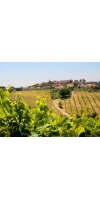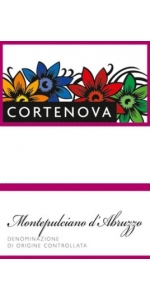Wine from Abruzzo

The Abruzzo wine region in Italy with over 65% of the region being mountainous. The Apennines peaks actually reach up to 9000 feet above sea level. The region lies between the foothills of the Apennines to the Adriatic Coast. The vineyards on the hillside are planted on calcareous clay that benefits from significant sun exposure that is ventilated thanks to the dry breezes from the Adriatic. All four provinces produce Montepulciano, Chieti, L’Aquila, Pescara, and Teramo. The southern province, Chieti, produces the largest quantity of wine. L’Aquila, which is the most mountainous province, produces a dry rose, which is labeled Cerasuolo. The most favored vineyards are in Pescara and Teramo, which is located in the north. These two provinces have more ferrous clay and limestone and are less fertile. The cooler climates produce the most concentrated wines. There were about 18,000 acres of wine vineyards in 2004.
The wine of Abruzzo is often a deep colored red with spice and pepper notes, and can be described as rustic. These wines are highly aromatic with an almost syrupy, thick mouth feel.
In the late 20th and early 21st century, Abruzzo earned the reputation of having the most exported wines in Italy.
Cortenova Montepulciano d' Abruzzo is made from 100% Montepulciano d'Abruzzo
Deep ruby red color with violet highlights and a pleasant and fruity bouquet. Full bodied, soft tannins and good acidity.
Excellent with pasta dishes and red meats.
Cortenova Montepulciano d' Abruzzo is made from 100% Montepulciano d'Abruzzo
Deep ruby red color with violet highlights and a pleasant and fruity bouquet. Full bodied, soft tannins and good acidity.
Excellent with pasta dishes and red meats.
- back
Selected Options
Regions
Categories
Pricing
Countries
Regions
Grape Types
Wineries
Organic/Free Shipping
Orin Swift Abstract Red is made from Grenache, Petite Sirah and Syrah.
The 2022 Abstract pours a dark purple core with a neon, ruby rim. The nose is quintessential Abstract but with a broodier twist-notes of ripe black plum, cacao, black pepper, cedar, dried porcini, forest floor musk and sweet oak. The entry is coating and flooding with hints of blueberry preserves, tarragon, balsamic glaze and anise. Bright and lifting through the palate, the finish offers an umami note akin to eggplant yakitori.
MATURATION Aged eight months in French Oak, 31% New ALC/VOL 15.3%
Torbreck Runrig Shiraz - Viognier is made from 98% Shiraz, 2% Viognier.
RunRig often draws comparison with the beautifully fragrant and tautly structured wines from the steep slopes of the Northern Rhône Valley’s Appellation of Côte Rôtie. Shiraz from old dry grown Barossa vineyards is blended with Viognier, complementing the strengths and complexities of these individual parcels of fruit, whilst giving the resulting wine a further dimension.
The Highland clans used a ‘RunRig’ system to distribute land amongst their clansmen in a series of widely dispersed holdings. The emphasis was not on any one farm but rather the communal element of the whole. Shiraz from old dry grown vineyards is blended with Viognier, complementing the strengths and complexities of these individual parcels of fruit, whilst giving the resulting wine a further dimension.
Review:
Tasting the RunRig beside the Descendant is always a wise move, in order to gain some contextual understanding of how they are similar and, perhaps more importantly, how they differ. This 2020 RunRig was sourced from six different vineyards across Barossa (in Lyndoch, Rowland Flat, Moppa, Ebenezer, Light Pass and Greenock) and includes a 2% “dosage” (as winemaker Ian Hongell described it) of Viognier. Matured for 30 months in a combination of new French oak (50%) and second and third fill barrels, the wine rests on its lees for that time. The lower percentage of Viognier here is a seductive and effective thing, adding just enough slick and polish to make this the sybaritic wine that it is, but little enough to allow the grunt, grit and muscle of the Shiraz from all those glorious locations to shine through. Despite the very long time in oak, the wine is balanced and excellent, big in almost every possible way but with an undeniable sense of class and length of flavor. Executed with detail and precision, this wine is clearly defined in its expression of house style
-Wine Advocate 97+ Points





